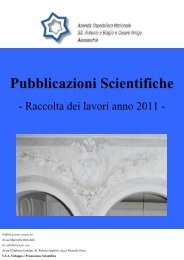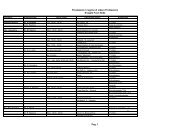Working Paper of Public Health Volume 2012 - Azienda Ospedaliera ...
Working Paper of Public Health Volume 2012 - Azienda Ospedaliera ...
Working Paper of Public Health Volume 2012 - Azienda Ospedaliera ...
You also want an ePaper? Increase the reach of your titles
YUMPU automatically turns print PDFs into web optimized ePapers that Google loves.
<strong>Azienda</strong> <strong>Ospedaliera</strong> Nazionale“SS. Antonio e Biagio e Cesare Arrigo”<strong>Working</strong> <strong>Paper</strong> <strong>of</strong> <strong>Public</strong> <strong>Health</strong>nr. 17/<strong>2012</strong>Mechanical ventilator - a device designed to support or replace spontaneous respiration - isused in patients with acute respiratory crises and/or in long-term therapy in chronichypoventilation patients affected by respiratory or neuromuscular disease.When noninvasive ventilation is not indicated, placement <strong>of</strong> an artificial airway is mandatory:endotracheal tubes for short-term use and tracheostomy tube for long-term use.Mechanical ventilation (MV) facilitates alveolar ventilation and pulmonary gas exchange;most commonly, MV is provided in intensive care unit. The most <strong>of</strong> patients receive shorttermMV therapy until the cause <strong>of</strong> respiratory crisis resolves or death occurs. However,some patients require long-term or permanent MV.Thanks to the evolution <strong>of</strong> technology and the simplification <strong>of</strong> MV devises a significantnumber <strong>of</strong> long-term MV patients receive the treatment in residential centers or at homereducing hospital stays and costs.In healthy subjects secretion clearance is primarily accomplished through mucociliary actionand cough. However some patients, for heterogeneous causes, present an inadequatemucociliary action and cough.For instance, during invasive MV, the presence <strong>of</strong> a foreign body - represented by the tube -is an important stimulus to increase secretions production.Besides, frequently these patients are affected by COPD with a permanent increased secretionproduction and/or are motionless patients with inefficient cough.Impaired airway clearance mechanisms with infection risks associated with bypassed upperairways and immobility effect increased risk <strong>of</strong> pulmonary infections.From these clinical considerations emerges the importance <strong>of</strong> a correct management <strong>of</strong> thesecretions in the patient submitted to mechanical ventilation.We can distinguish the patients in 2 groups in view <strong>of</strong> the prevalence <strong>of</strong> obstructive bronchialillness (group A) or neuromuscolar disease (group B) considering the different characteristicsfrom our point <strong>of</strong> view.It results moreover important to differentiate the invasive ventilation from the non invasive.In patients submitted to invasive mechanical ventilation in the department <strong>of</strong> intensive care itis helpful to be able to have systems able to remove the deepest secretions, mostly if arepresent phenomena <strong>of</strong> atelectasia with stagnation <strong>of</strong> secretions that usually concern thedeepest zones <strong>of</strong> lungs.The VEST devise is effective in this occasion also in patient not collaborating submitted tocontrolled ventilation.2



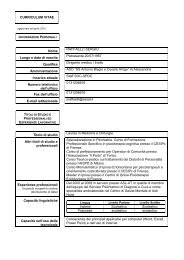
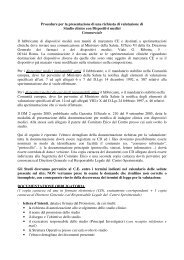

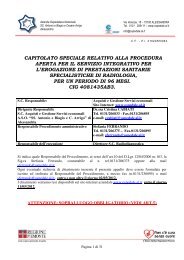
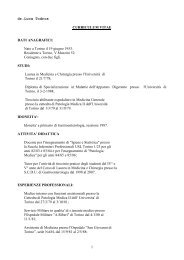
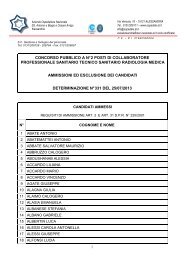

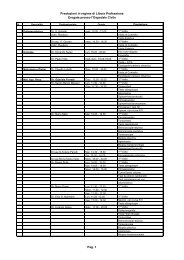


![[torino - 1] lastampa/urc/01 ... 26/10/09 - Azienda ...](https://img.yumpu.com/44058002/1/190x32/torino-1-lastampa-urc-01-26-10-09-azienda-.jpg?quality=85)

